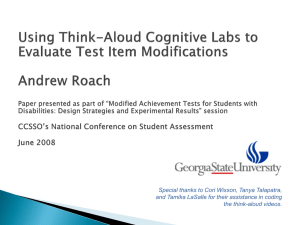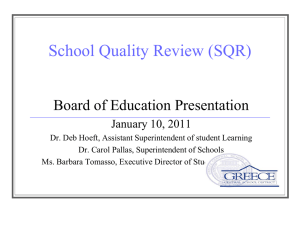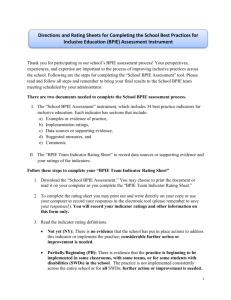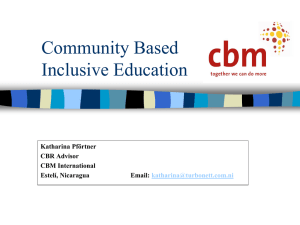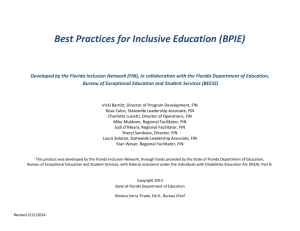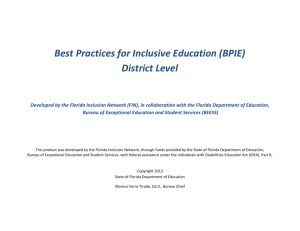Indicator Rating Tally Sheet
advertisement
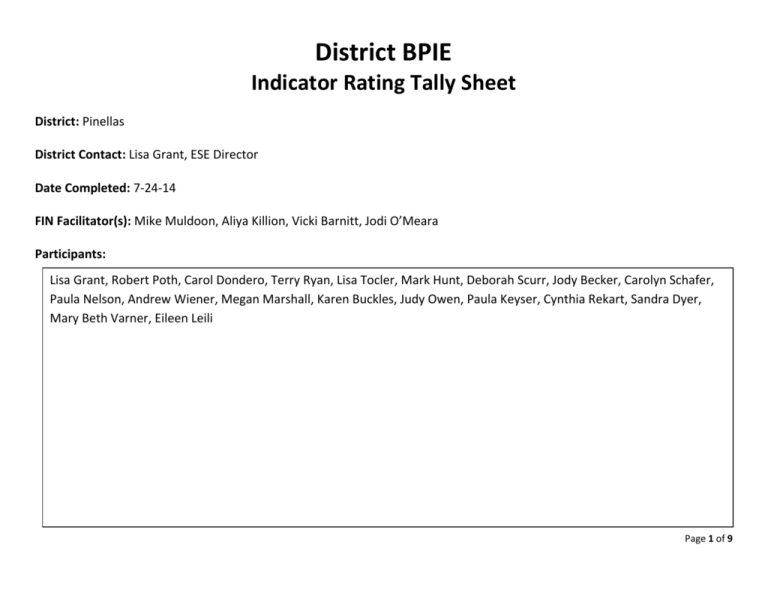
District BPIE Indicator Rating Tally Sheet District: Pinellas District Contact: Lisa Grant, ESE Director Date Completed: 7-24-14 FIN Facilitator(s): Mike Muldoon, Aliya Killion, Vicki Barnitt, Jodi O’Meara Participants: Lisa Grant, Robert Poth, Carol Dondero, Terry Ryan, Lisa Tocler, Mark Hunt, Deborah Scurr, Jody Becker, Carolyn Schafer, Paula Nelson, Andrew Wiener, Megan Marshall, Karen Buckles, Judy Owen, Paula Keyser, Cynthia Rekart, Sandra Dyer, Mary Beth Varner, Eileen Leili Page 1 of 9 BPIE DISTRICT INDICATOR Tally Sheet Leadership and Decision-Making Indicator Implementation Status Not Yet 1. District analyzes data to identify barriers and initiate improvement steps that increase the number of students with low- and highincidence disabilities in general education and natural contexts in every school. PB 2. District data reflects that in each school there is alignment to the natural proportion of SWDs in the district. NY 3. District provides SWDs with the same school choice options as students without disabilities to ensure all SWDs receive educational services in their neighborhood school or school of choice. NY 4. District data reflect that SWDs, ages 3–5, receive special education and related services in the regular early childhood program or kindergarten, with peers without disabilities. 5. District-level administrators allocate special education units and resources to all schools and grade levels, based on student need and flexible models of service delivery, to facilitate best practices for inclusive education in every school. Partially PA PB Data Sources/ Supporting Evidence Fully Looking at LEA profile…trend shows no growth in LRE/ ind. 5a; Have data but need to use it systematically, including kids with more significant disabilities. Need to focus more on secondary level. As a system we’re still beginning. Some schools are doing this, but not all. Still have center and cluster schools; students with EBD sometimes affect the data on ratios. Some students are placed in clusters and some schools have more supports than others. District does not have policies that permit choice for all SWDs. Perspective that all SC units are special diploma. Schools make decisions for how their students are served. Blended PreK in place; TATs program has data that shows Pinellas is leading the state in PreK inclusion. We examine data very closely to make decisions about kindergarten placements. Still some SC in K. Charter schools are not implementing PreK inclusion. Have full time ASD PreK classes. District clusters SWDs to identify supports needed. Secondary level, CT or SF do not have enough staff; training not adequate for deliv. models. Charter schools don’t have flexible options (schools make their own decisions). Challenge is balancing resources; need to build a system at the district level to respond to individual student needs. Page 2 of 9 Leadership and Decision-Making Indicator Implementation Status Not Yet 6. District has key personnel with expertise in inclusive best practices for all SWDs who oversee, coordinate, monitor and provide technical assistance (TA) for the implementation of best practices for inclusive education at the district and school levels. NY 7. District has key personnel with expertise in the MTSS and positive behavior intervention plans (PBIP) who provide ongoing professional development (PD) and TA to schools to ensure that students who need them receive multi-tiered behavior supports in general education classrooms and natural contexts. 8. District data reflect that SWDs who have behavior support needs are not excluded from the general education classroom at a higher rate than their peers without disabilities. 9. District transportation policies and schedules indicate all SWDs arrive and leave schools and district facilities at the same time, in the same place and on the same buses as students without disabilities, unless otherwise stated in the student’s IEP. Partially PM NY PA Data Sources/ Supporting Evidence Fully Don’t have anyone at the district with expertise. Need to build capacity. Some people have knowledge, but we need to replenish the “brain trust” – we have lot of people with knowledge to build on. But we don’t oversee or monitor with consistency. Need to start by looking at school based personnel to build capacity. Sometimes principals don’t make time for teachers to collaborate and have discussion. Not targeting students for supports in gen. ed., sometimes it’s about moving them into more restrictive environments. Gen. ed. Teachers are left out of the loop and don’t have training or a voice in the decision. Lack of collaboration between gen. ed. and ESE. Have good systems of MTSS and have trained leadership teams. Have TNT teams to educate staff in schools to keep them in the LRE. Need to expand this. We could use more resources in place (especially for Tier 1 level supports). Data show disproportionality in Black EBD. In school suspension has higher risk compared to gen. population. Have some plans in place, but impact not felt yet. EBD Centers run one hour less than other schools. They have a shortened school day. Some schools spend more time on the bus due to busing to cluster schools. Some schools have busses that stop at other places to drop off students. State policy prohibits some students w/out disabilities to receive transportation on the same schedule as their siblings…(loss of instructional time of students without dis. From same family) Page 3 of 9 Leadership and Decision-Making Implementation Status Indicator Not Yet 10. District uses decision-making guidelines to ensure schools transition all SWDs from grade to grade, school to school and district to district to maintain placement in the least restrictive environment. Partially Fully Lacking district guidelines or technical assistance – schools have a process, but no district written process. Some processes in place for SW significant disabilities, but not those with mild disabilities. Elementary schools are doing this, but not across the district. HR uses questions for support staff and school administrators are asked in interview about SWDs and all other diversity issues (cultural) to best meet the needs of all students. Protocols aren’t in place for the administrator doing the hiring. May not include bus and cafeteria. PB 11. All district departments and schools use job interview questions to appraise an applicant’s knowledge and beliefs pertaining to diversity and best practices for inclusive education, as applicable to the position. Data Sources/ Supporting Evidence PB Instruction and Student Achievement Indicator Implementation Status Not Yet 12. District data reflect that SWDs receive most, if not all, of their education and related services in age- and grade-appropriate general education classes, regardless of the type or severity of their disability. 13. District and school leaders receive ongoing and current information and professional development about best practices for inclusive education for all SWDs. Partially PB PB Data Sources/ Supporting Evidence Fully LEA Profile data; Not seeing as much with our low incidence disabilities. Could do a better job of getting them out for electives, PE, etc. Large proportion of students in center schools. Scheduling is an issue. Not enough progress for full inclusion (sometimes just for reading). Need to know how to do it for a greater impact. Completed a 3 day institute with administrators in attendance. Many sessions were on inclusive practices…will repeat again next year. District plan includes goals for this. Page 4 of 9 Instruction and Student Achievement Indicator Implementation Status Not Yet 14. District provides job-embedded, collaborative PD and TA to all schools to integrate IEP goals and objectives and the general education standards in general education classes and natural contexts. 15. District provides ongoing PD and TA to all school leaders on the implementation of a flexible scheduling process and collaborative teaching service delivery models to provide instruction and support to all SWDs in general education contexts, regardless of the type or severity of their disability. 16. District provides PD and TA to schools in the use of a variety of tools to gather and analyze data and evaluate the effectiveness of instructional and behavioral interventions for all SWDs in general education and natural contexts. 17. District provides ongoing, job-embedded, collaborative PD and TA to school-based personnel to implement best practices for inclusive education, including instruction and assessment for all SWDs based on the Florida Standards. 18. District facilitates and supports access to AT, including augmentative and alternative communication (AAC) devices, as determined by the assessed need of SWDs for meaningful learning, participation and communication in general education and natural contexts. Partially Data Sources/ Supporting Evidence Fully PLCs are in place in some schools, students with IEPs are discussed. District conducted LLC meetings with all schools on the new standards. Center schools should be included in these conversations. Need to begin with administrators. Scheduling TA was provided by FIN in the past, but not currently place. School leaders do not have a published schedule of PD or TA on this process. PB NY PB PB F Do this but not for all SWDs in gen. ed. This happens more in situations where we are looking for a more restrictive environment. District provides tools and processes via MTSS. Doing a good job with general walk- throughs of teacher classrooms. Have not embraced ESE in the process of training and TA to focus on FL Standards. Some job embedded is occurring in some cases, e.g., LLCs, PLCs, SIM structures, etc. Some parents express that they don’t have enough information. But district supports access and information for parents with a team decision approach. Difficult to keep up with the changing technology, but are providing access. H/H, dropout, and sec. have some unique situations. Sometimes devices are not used for meaningful learning…need follow up to make sure they are using them effectively (ongoing support). We have a GREAT team, but may not be enough to meet the needs of such a large district. Page 5 of 9 Instruction and Student Achievement Indicator Implementation Status Not Yet 19. District provides job-embedded, collaborative PD and TA on the use and integration of AT (including AAC) to special and general education teachers, instructional support personnel and family members at all schools. 20. District has data that reflect an increasing number of students with low-incidence disabilities and/or receiving instruction through the access points are educated in general education classes, with supplementary aids, services and curricular modifications as stipulated in student IEPs. 21. District data reflect that SWDs receive supplemental supports and services in order to participate in all school and district extracurricular activities. 22. District provides support and resources to schools to facilitate the development of positive, interdependent relationships among all students with and without disabilities in instructional and noninstructional general education and natural contexts. Partially PM NY PM PM 23. District data reflect that all SWDs are given equal consideration for recognition through honors, awards and other designations offered by schools. PA Data Sources/ Supporting Evidence Fully See comments above. Not enough resources to go around. Schools are working with the LATS team; training is available for schools from FDLRS. Some educators don’t know what is out there for their students. Need to make sure all the info. gets out to ALL parents. Students are not receiving modifications on curric. standards in gen. ed. Need more collaboration between ESE and gen. ed. teachers. State policy barriers prevent this from happening….course codes, teacher certification requirements, etc. SWDs are included across many varied levels of extracurricular activities – safety patrol, etc. School admin. need more awareness on this (e.g., including them in less obvious activities like cheerleading). Some schools have had training on peer supports for low-incidence dis. MS peer program was supported at the district level. Ongoing yet processes are not well defined. FDLRS parent services provides DWD training to parents across the district. Parent shared that SWDs are not always included in the same ceremony but get recognition – not happening in all schools. We don’t have any data on this per individual schools. Our high schools do provide graduation and ceremonies in a standard way. Elem. Level has character education with monthly recognitions for all students and parents attend. Think this is happening, just don’t have any data to reflect it. Page 6 of 9 Communication and Collaboration Indicator Implementation Status Not Yet 24. District provides all district and school personnel with information and resources pertaining to the use of person first language in all written and verbal communications. 25. District documents, forms, program materials and other communication that refer to SWDs reflect the use of person first language. 26. District provides information to families about research-based, inclusive educational practices and ways they can support their child’s learning, independence and participation at home, at school and in the community. Partially Fully Personnel still use label-driven language because they have never been aware of PFL. There is no resource from the district that goes out to all – happening in some ways- e.g., FDLRS supports PFL in training. Our teachers are referred to by the label of kids they teach. Mission statement does not reflect PFL. NY NY FDLRS (transition conference), parent advocate, ESE advisory board membership – all provide information on inclusive education. One parent shared that she had not received anything. Don’t have enough resources to support printing for all the information. Some families don’t have access to internet. Some parents don’t get information about the full continuum of services. Need to do more PR (e.g., Facebook). Not systemic or consistent. Mostly available for those who know to ask. Facilitated IEP training has been offered. Not sure how much it’s implemented. PM 27. District provides resources to all district and school staff that include strategies for effective family communication and collaboration to increase learning and achievement for all SWDs in inclusive classrooms and natural contexts. 28. District uses a variety of processes and tools to involve family members of students with and without disabilities in district wide decision-making and planning processes, including initiatives related to inclusive practices. 29. District disseminates information to all families in the same manner and at the same time. Data Sources/ Supporting Evidence PB PB F Use survey to gather parent information; parents are on ESE advisory and provide guidance (but may need so improvement on how advisory is used). Parents are part of calendar committee. Dr. Greco has opportunities to get parent input across the district; school board offers time for parents to speak. Sometimes delays for families who do not speak English. Translation programs have reduced this. Still some parents that don’t get info. due to electronic formats. Page 7 of 9 Communication and Collaboration Indicator Implementation Status Not Yet 30. District has partnerships with colleges, universities and career and technical schools to provide inclusive, postsecondary educational and career opportunities for students with a significant cognitive disability, ages 18–21, to enroll in programs with adults without disabilities. Partially Data Sources/ Supporting Evidence Fully PM Extended transition programs: Project Stingray; PTEC; Have a good variety of programs, but aren’t reaching everybody based on LEA Profile data. Priority Indicators Selected: Indicators 6, 13, 15, 17, 26 Additional Comments/Notes: IDEAS FROM THE GROUP REGARDING SUPPORTING SYSTEMIC CHANGE: 1. Include ESE teachers in the LLC’s membership 2. Focus on school leadership: School leadership is key to so many of these!! Leaders need to know the benefits of inclusion so they can lead best practices. (Team leaders and school leaders) Best Practices for Inclusion and Collaborative teaching models for school leaders- want leaders to walk the walk and talk the talk Systems of support- on-going, job embedded PD Create system of values, not compliance. 3. Support and PD for general education teachers is needed across the county rather Page 8 of 9 than school-based pockets of good things happening. ALL teachers to include support staff, school employees such as cafeteria employees, general education and ESE teachers. 4. Family involvement and communication between district and families need to continue to be a focus. Besides the ESE parent advisory, other parent to parent pieces pulling in FDLRS and other projects to support these efforts. Simple efforts such as providing parents and others with the FIN handout on “What is Inclusion?” at the time of eligibility would be significant. (Indicator 6) 5. Interest in possibly adding job interview questions (Indicator #11) 6. Will increase collaboration between FIN and FDLRS for planning, implementation, and support 7. Will schedule BPIE team to come back together a couple times a year to discuss progress, revisit plan, etc. Page 9 of 9
